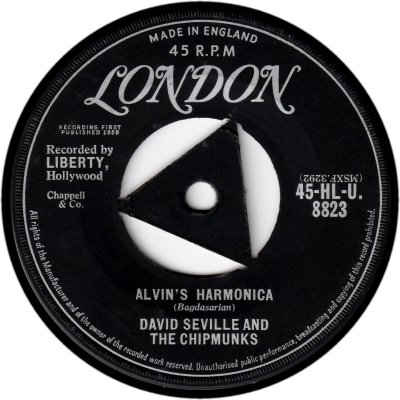
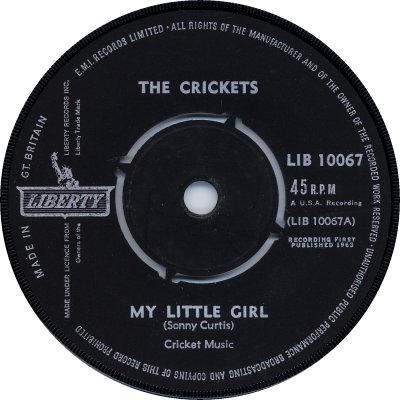
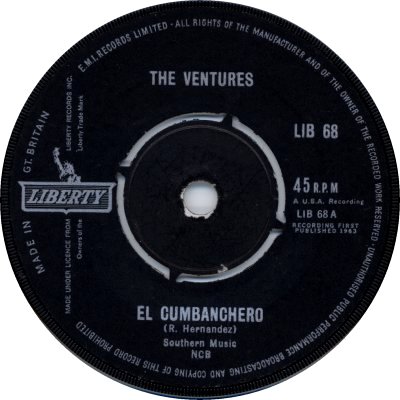
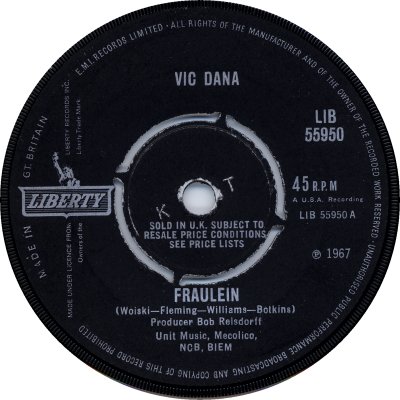
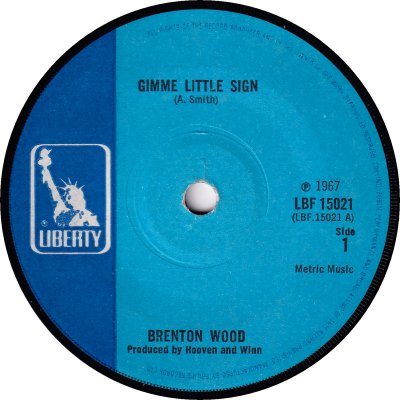
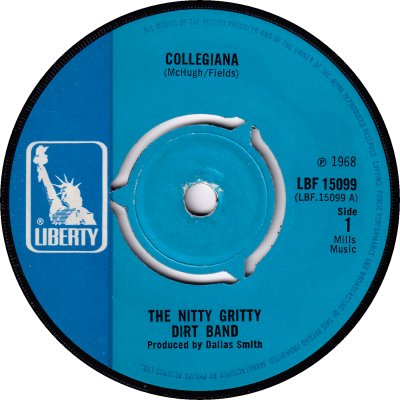
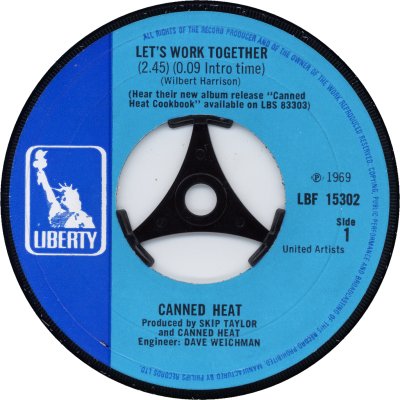
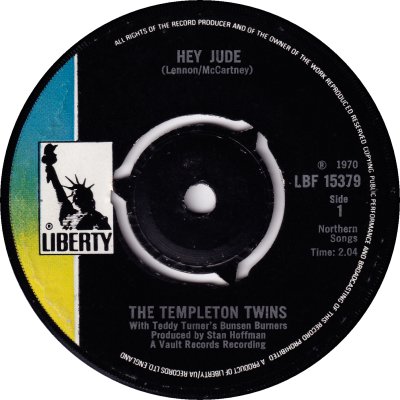
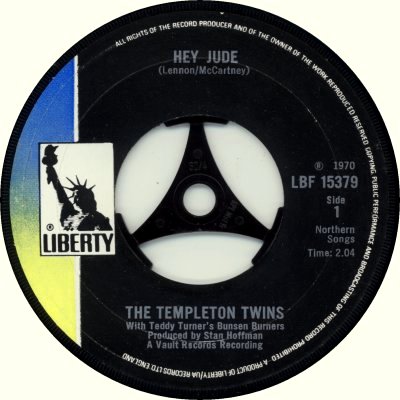
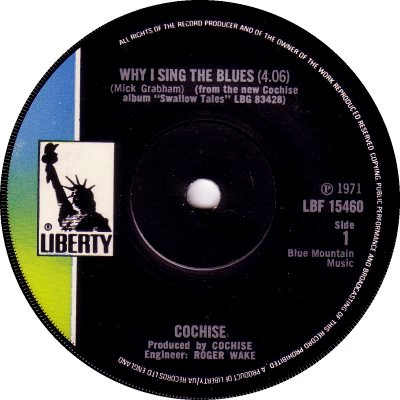
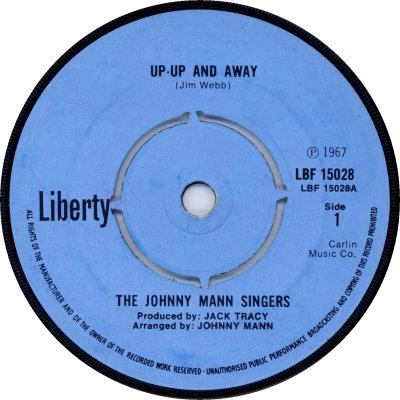
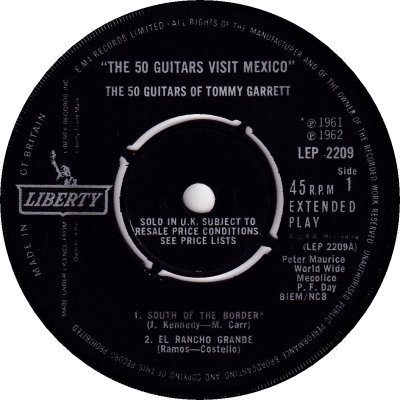
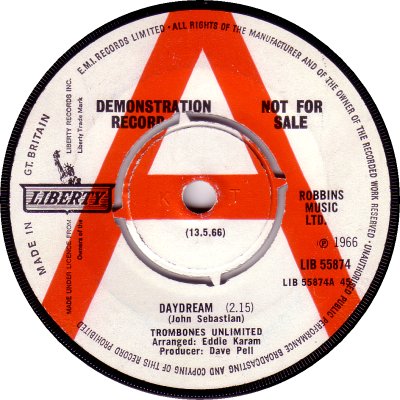
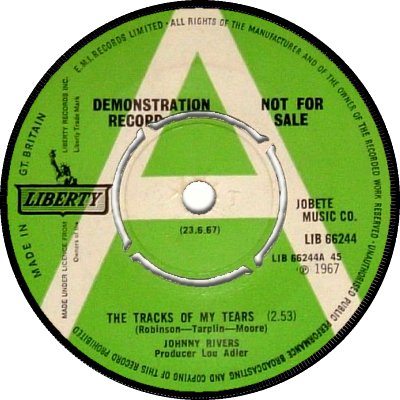
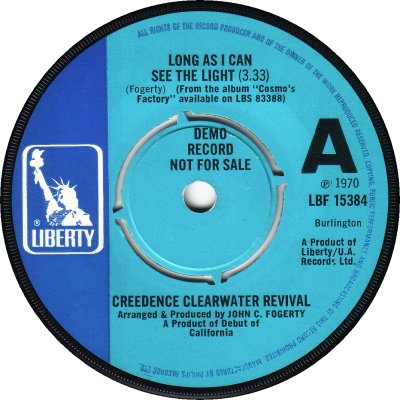
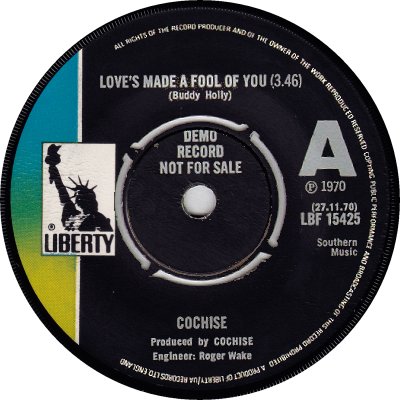
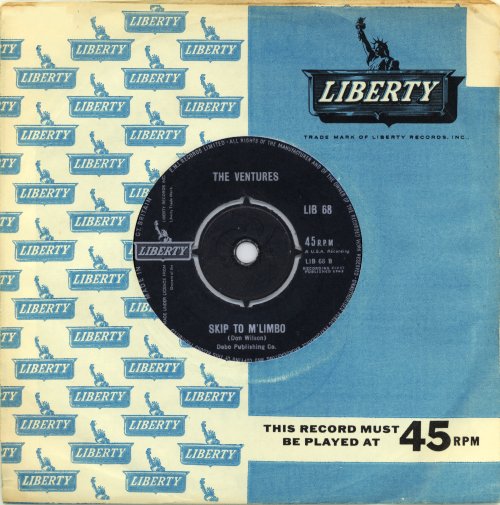
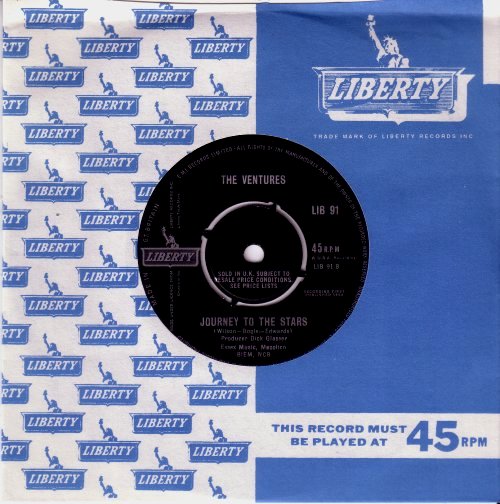
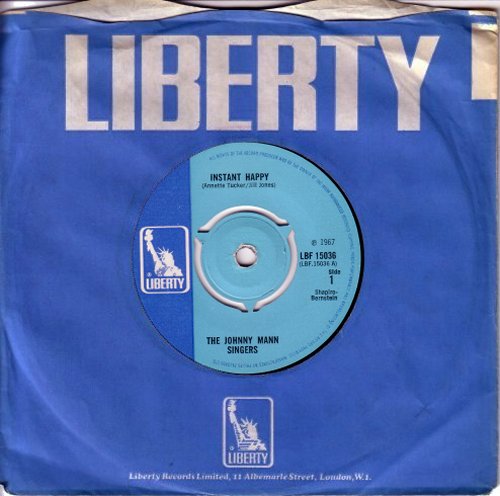
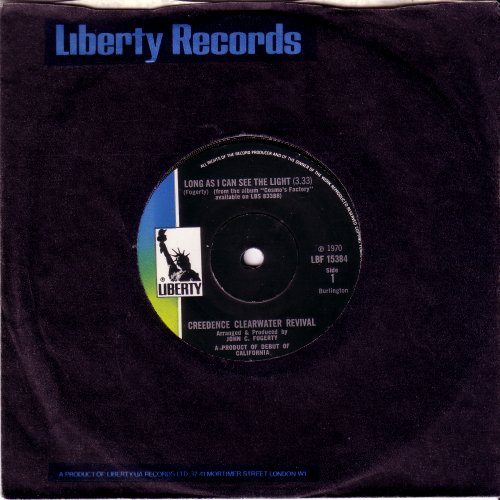
American, out of Hollywood, California. Liberty was brought into being by Simon Waronker and Jack Ames in 1955. 'Billboard' of the 12th of March of that year referred to it as a 'newly formed Pop indie label' and said that its first releases were due out that month. At first Liberty concentrated on Big Band Jazz and MOR Pop material but it broadened its scope over the years. It registered an early success with Julie London's 'Cry Me A River' b/w 'S'Wonderful' (55006; 10/55), and 'BB' of the 2nd of March 1957 was able to report that, having grown steadily over the past two years, it had recently opened its own recording studio. Other hits followed by the likes of Billy Ward & The Dominoes, Patience & Prudence and Eddie Cochran, but the company's financial position became somewhat rocky. Its salvation came in the form of a couple of records by David Seville, who was responsible for two huge-selling singles in 1958: 'Witch Doctor' b/w 'Don't Whistle At Me Baby' (F-55132; 3/58) under his own name, and then a novelty Christmas record, 'The Chipmunk Song' b/w 'Almost Good' (F-55168; 11/58) under the alias of The Chipmunks. 'BB' of the 15th of December 1958 commented that the Chipmunks' record was 'The fastest moving disk of the year, possibly in the history of the record business'. Two hundred thousand copies of it were being shifted per day; sales had already reached the two-and-a-half million mark, and they were expected to be comfortably in the three millions by the end of the year. Incidentally the Chipmunks took their names from three prominent Liberty people: Simon Waronker, vice president / general manager Alvin Bennett, and engineer Theodore Keep.
Liberty was able to build on these successes, and it became an attractive proposition. The idea of it becoming a publicly held corporation was considered in 1961; and then in 1962 it was bought by a company called the Avnet Electronics Corporation. 'BB' of the 21st of April said that the proposed deal was being put before Avnet's shareholders, and a few weeks later 'BB' of the 9th of June was able to report that the purchase, which didn't involve any changes to Liberty's management, had been carried out. As it turned out, Liberty was not to remain in Avnet's hands for very long, but while it was with the corporation it bought Imperial Records, along with its strong back-catalogue, at the behest of Avnet. That acquision took place in the autumn of 1963, and as a result of it 'BB' of the 12th of October was able to describe Liberty as 'One of the industry's strongest firms'. In passing, the article mentioned that Avnet had paid more for Liberty than had ever been paid for a record company before. Perhaps more importantly, it revealed that Bennett - who by this time had become president of the company - was negotiating to buy Liberty back. The negotiations were successful, and 'BB' of the 19th of October broke the news that Avnet had sold Liberty to Bennett and three colleagues of his, Hal Linick, Sy Zucker and Ray Sandler. According to the article Simon Waronker had retired from his position of chairman of the board at the time of the purchase. It added that as Liberty had been taken over by Avnet on the 25th of March 1962 it had been with that company for a mere sixteen months.
1967 saw Liberty establishing a British arm, which signed and recorded UK artists. 'BB' of the 15th of April expected that the UK company would be set up 'within eleven weeks'. The company's licensing agreement with EMI here was due to expire on the 30th of June, and plans for independence were ready well in hand, even down to the appointment of publicity staff and an executive to handle the Jazz label Blue Note, which was then under Liberty's wing. 'BB' of the 17th of June was in a position to state that head of the UK Liberty operation Bob Reisdorff had agreed a pressing and distribution deal with Philips; it was to start on the 1st of July, the date when Liberty's UK arm was due to be launched. A full staff of ten people had moved into Liberty's new British headquarters in London, and they had been joined there by the staff of Liberty's publishing offshoot, Metric Music.
Back in America, however, there was a big change coming, in the form of another takeover. 'BB' of the 6th of April 1968 announced that Liberty had been bought by the Transamerica corporation for $24m, and that it was to become a wholly-owned subsidiary of United Artists Records - Transamerica had bought that company in April the previous year. Liberty's management was to be retained, with Al Bennett getting a seat on UA's board of directors. 'BB' of the 22nd of June altered that somewhat: United Artists Records was now to become a subsidiary of Liberty Records, which in turn was to become a wholly-owned subsidiary of United Artists Pictures. The article went on to say that while the two record companies would continue to operate autonomously their operational functions would be consolidated. Bennett seems to have found his new role unacceptable after a while: 'BB' of the 15th of August 1970 revealed that he was 'on vacation' and that it was uncertain that he would return before the end of his three-year contract.
What appeared to be the end for Liberty came early in 1971. 'BB' of the 23rd of January broke the news that the United Artists Corporation was to abolish its multi-label concept in favour of a single brand, United Artists Records. Acts from Liberty and the other associated labels, including Minit and Imperial, would be transferred to the United Artists label, which would be given a new logo. The final Liberty single came out in February 1971 in the USA, though the label hung on for a couple more months in the UK. All was not lost, however. After changing hands a couple more times United Artists Records ended up in the hands of Capitol-EMI and was given the name Liberty United Records Inc., as its entitlement to use the United Artists name was time limited and hadn't long to run ('BB', 12th February 1979). Then in 1980 'BB' of the 6th of September reported that in order to avoid confusion between the United Artists Corporation and the now-Capitol-EMI-owned United Artists Records the record company was to reassume the name Liberty Records. It was given a bright new cream-coloured label and it enjoyed a separate identity until 1984, at which point it was absorbed into EMI America.
In Britain, Liberty product was initially licensed to Decca, and it came out on the London label with a source credit to Liberty (1). The arrangement proved fruitful of several hits: Jane Morgan topped the Singles Charts with 'The Day That The Rains Came' b/w 'La Jour Ou La Pluie Viendra' (HLR-8751; 11/58); David Seville's 'Witch Doctor' b/w 'Don't Whistle At Me Baby' (HLU-8619; 5/58) only just missed out on the Top 10; and, while 'The Chipmunk Song' surprisingly failed to score here, The Chipmunks' Ragtime Cowboy Joe' b/w 'Flip Side' (HLU-8916; 7/59) reached No.11. Further hits came by courtesy of Jane London, Patience & Prudence, Eddie Cochran and Alfi & Harry, the latter being another David Seville pseudonym. Decca must have been impressed, as 'BB' of the 19th of September 1960 indicated that Liberty products were to be given a push, with an increase in the number of its albums that were being issued here and with any of its singles which entered the American Top 100 automatically being released on London. Despite the new emphasis Liberty moved on, the following year. 'BB' of the 30th of October 1916 revealed that EMI was to handle its records from the 1st of February 1962 and was to give it its own label identity. The label name and catalogue numbers were to be the same in every country covered by the deal, which would simplify international matters. In passing, the article observed that a study by EMI had revealed that Liberty had been second only to RCA Victor among record labels for singles sales in the UK over the past fifteen months.
Liberty stayed with EMI until 1967, when it set up a British company for itself and went independent, as mentioned above, with Philips handling manufacture and distribution. Following the purchase of its American parent by Transamerica it was integrated into United Artists Records in this country; 'Record Retailer' of the 19th of June 1968 said that Al Bennett was in London to take part in talks about the process. Plans were formulated and put into action, and the integration was completed early in 1969, the combined company taking the name Liberty-United Artists ('RR', 5th of February). In May of that year there was speculation that Liberty's deal with Philips might not be renewed, and that the label might revert to a licensing deal with EMI and join United Artists there ('RR', 28th May), but in the event Liberty stayed with Philips, the new contract being timed to expire when United Artists' agreement with EMI ran out. In addition Liberty-United Artists emphasized its independence by setting up its own sales force, at first concentrating on the big cities ('RR', 11th June). In 1970 the company examined the prospect of carrying out distribution for itself ('RR', 4th April), but decided against.
Liberty's renewed arrangement with Philips was supposed to come to an end in February 1971, but the company invoked a get-out clause and left seven months early in order to switch to EMI ('RR', 25th July 1970). As it happened, however, the decision of its American owner to merge all its labels into one, referred to above, meant that Liberty was not to be a member of the EMI family for very long. 'RR' of the 3rd of April 1971 reported that the Liberty label, which it said was for 'contemporary Rock', was to be phased out. The last Liberty single of the '70s came out on the 23rd of that month, and no more was heard of Liberty as a label until its re-emergence in the autumn of 1980.
Liberty used a couple of label designs in the '60s and '70s. A silver-on-black one served throughout the EMI years (2, 3), with a 'Sold in the U.K.' legend being added in the centre of the label from February 1964 (4, 12). Independence in 1967 saw a new design and two-tone blue labels being introduced. As manufacture was now by Philips / Phonodisc, singles could be found in any of three forms: imperforated with a raised 'motte' around the spindle hole (5); with a three-pronged push-out centre (6); or with a large spindle hole and a 'spider' (7). In July 1970, when Liberty moved from Philips to EMI, the colour scheme changed to black-and-multicoloured, but the break doesn't appear to have been a clean one. A couple of Philips-era singles can be found with the black labels (8, 9), and a couple of early EMI-era singles had the blue ones, sometimes with EMI-style four-pronged narrow perforations (15), even though they had 'Manufactured by Philips Records' at the bottom. Nor is it uncommon to find black-labelled singles in blue sleeves. The black labels, perforated or not (10) stayed until the end. The monochrome pale blue labels (11) from EMI were used on some copies of a couple of popular singles that were initially released in the 1960s; they appear to be re-pressings, carried out after Liberty's demise and in the absence of a supply of the proper labels. The 'polo mint' marks around the spindle holes seem to have first appeared on EMI singles in July 1972, so presumably the records concerned date from after that.
Demo labels from the first EMI period followed the standard EMI pattern, starting out as white with a large red 'A' (13) and changing to green with a large white 'A' (14), which they did in October 1966. There were no demo labels during the Philips years, but they resurfaced when EMI took over manufacture in 1970. This time around the labels were overprinted with a medium-sized 'A' and the appropriate text (15, 16). With regard to catalogue numbers, there were four different kinds during the first EMI years. Singles which had an American counterpart bore the same number as the American versions, which were in a 55000 series, but were given an LIB prefix (4), while ones which had no direct American counterpart were numbered in the LIB-10000s (2). Singles that were sourced from Liberty's Dalton subsidiary were given the same two-figure numbers as the original Dalton ones, but again with a LIB prefix (3). EPs had their own LEP-2000 series (12). After the move to Philips, singles were numbered in an LBF-15000 series, not all of which were used in this country. This was retained after the move to EMI. Three different designs of company sleeve were used. The one from the first EMI era had multiple logos, briefly with some black text (17), then with blue (18). The Philips-era one had the company name in large letters at the top (19), while the union with United Artists saw the introduction of a black sleeve (20).
Liberty registered its fair share of Singles Chart successes in this country during its 'own label' years. Its most consistent hit-makers under its own name were Bobby Vee (five hits from 1962-63), P.J. Proby (nine from 1964-68), Canned Heat (four from 1968-70) and Creedence Clearwater Revival (eight from 1969-71). In the summer of 1969 Creedence provided the label with its sole No.1, 'Bad Moon Rising' b/w 'Lodi' (LBF- 15230; 8/69), though the Heat nearly matched that feat a few months later when 'Let's Work Together' b/w 'I'm Her Man' (LBF-15302; 1/70) stalled at the No.2 spot. The British arm of Liberty signed some names that went on to be well known - Hawkwind, Family, Man, the Bonzo Dog Band, Groundhogs, The Idle Race and Mike Batt - but only the Bonzos registered in the charts, getting 'I'm The Urban Spaceman' b/w 'Canyons Of Your Mind' (LBF-15144; 10/68) into the No.5 position. As usual the discography below only covers the '70s.
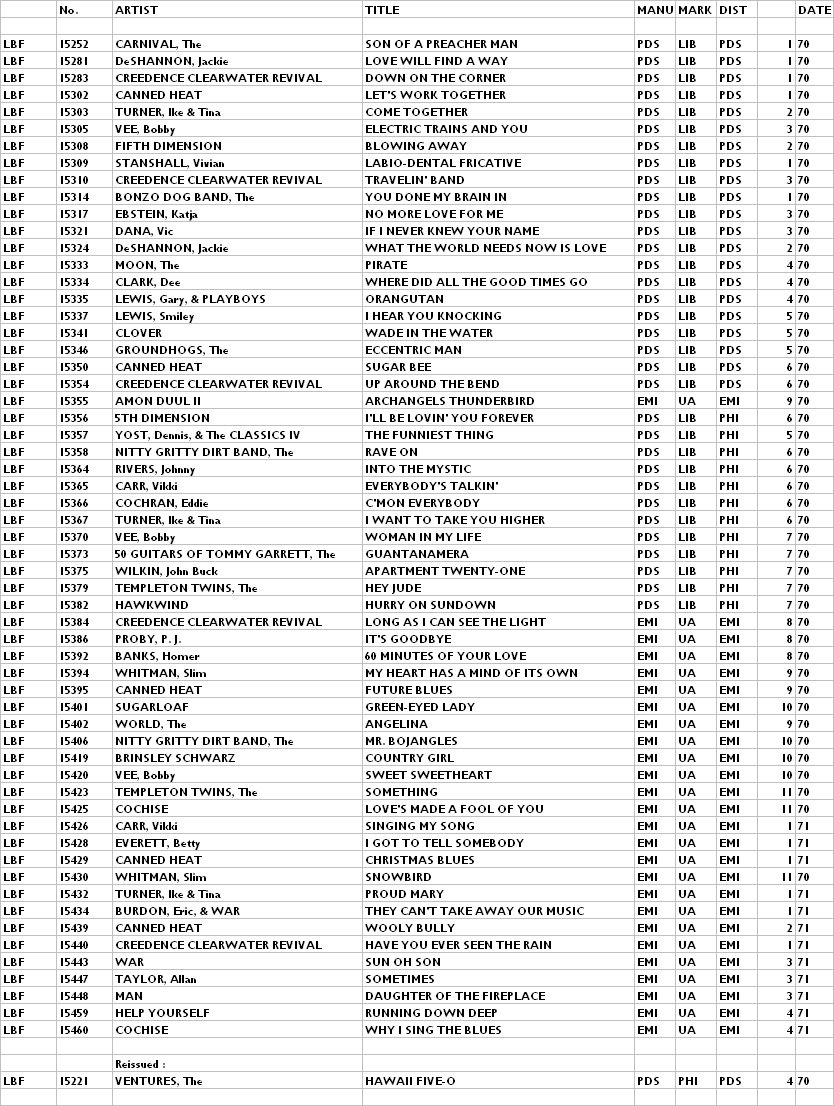


Copyright 2006 Robert Lyons.

